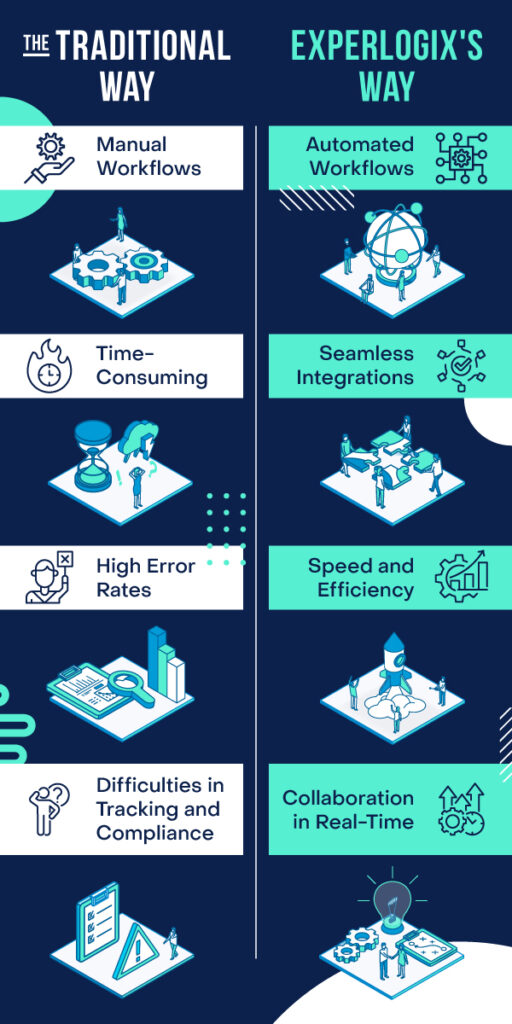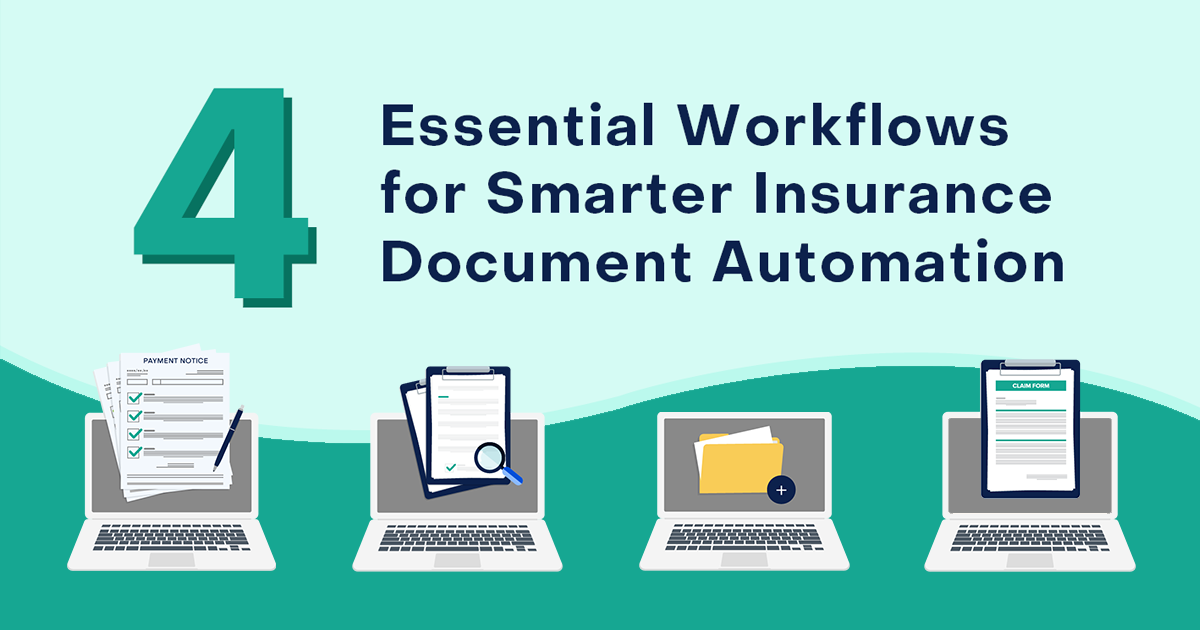As someone who works with multiple clients on multiple projects all at the same time, I can safely say that having a way to manage documents is a complete game-changer. When I first started out, I’d create documents from scratch, rework version after version, and regularly spend a good chunk of time trying to find buried invoices, contracts, and proposals.
It wasn’t a good system—but it’s the system far too many businesses use. It wasn’t until I discovered document management software that things changed.
Here’s a breakdown of how and traditional document chaos is history and how Experlogix is redefining document management for a smarter, seamless future
What is a Document Management Workflow?
A document management workflow is a structured approach to handling documents from the moment they’re created or received until they’re either archived or binned.
The aim of a “good” document management workflow is to seamlessly move documents through different stages.
This might include:
- Creation or receipt of documents
- Review and approval processes
- Version control and tracking changes
- Distribution to relevant team members
- Storage and retrieval
- Archiving or disposal
Each step is carefully planned and automated where possible so nothing falls through the cracks.
Why Document Management Matters Today
If you’re thinking, “Do I really need this?” the short answer is: absolutely.
Here’s why:
The Digital Tsunami Is Real
We’re creating more content than ever before. Every email, every contract, every invoice, every social media policy—they’re all documents that need managing.
Time is Money (No, Really)
76% of people spend 1-3 hours a day moving data from one place to another, and a further 73% spend 1-3 hours just trying to find a particular document.
That’s basically half a workday spent playing hide and seek with files. A proper document management workflow cuts this down dramatically, freeing up your team to do what they do best.
Compliance Isn’t Optional
Regulations like GDPR and HIPAA have certain protocols we must stick to, so proper document management isn’t just nice to have, it’s essential. One misplaced document or unauthorized access could cost you more than just a headache.
Remote Work Changed Everything
14% of the US workforce works from home and a growing number of companies are choosing to hire candidates in different timezones. This makes managing document workflows almost impossible unless you have an automated, strategic system.
Client Expectations Have Evolved
Almost anything is available in just a couple of clicks, so it’s no surprise that people expect instant access to information. A solid document management workflow helps you deliver on that.
The Traditional Approach to Document Management
The traditional way of managing documents involves handling everything yourself—from filing to tracking, retrieving, and staying compliant. While it can work in smaller, less complex setups, the cracks quickly start to show when you grow.
A typical manual workflow is labor-intensive and/or paper-heavy.
It might look something like this:
First draft/print the document > physically file it in a cabinet > dig through folders to find it
When a document needs approval or revisions, physical copies are passed from one person to another, increasing the chances of errors and prolonging the whole process.
The Main Challenges of Traditional Document Management
- It’s time-consuming. Each document needs to be printed, signed, filed, and retrieved manually, which can lead to significant delays (especially if multiple people are involved).
- It’s error-prone. Misfiled documents, missed signatures, or forgotten updates can cause costly delays or lead to compliance issues.
- It’s hard to track and stay compliant. Traditional document management tends to lack the sophisticated tracking features of digital solutions. This makes it hard to see who accessed a document, when it was last updated, or if it meets current regulations.
Experlogix’s Innovative Approach to Document Management
The new remote working trend, scattered teams, and stricter compliance laws mean traditional document management systems are no longer a safe bet. Instead of forcing you to tirelessly file documents IRL, Experlogix has reimagined the whole process.
We’re calling this “the Experlogix approach”.
Our advanced software blends automation with an easy-to-use interface so you no longer have to shuffle endless reams of paper or chase down approvals. It runs on powerful automation and seamless integrations to create an almost invisible workflow within your existing toolset.
What Makes Experlogix Different?
The two biggest differentiators of Experlogix and its manual alternative are the automated workflows and seamless integrations.
Automated Workflows
Experlogix removes the manual steps that slow things down, replacing them with automated workflows that handle routine tasks in seconds.
If you need a document reviewed or signed, the system automatically routes it to the right person while keeping everyone in the loop.
Each stage is tracked, too, so teams can see exactly where a document is in the process.
Seamless Integration with Existing Systems
One of Experlogix’s (many) standout features is its ability to connect with the systems you already rely on, like CRM and ERP platforms.
This creates a unified source of truth because data flows effortlessly between your main business apps and your document management system.
The Benefits of Experlogix’s Document Management Workflow
It’s Speedy
Our automated workflows are anything but clunky. Tasks that used to take hours (or even days) now happen instantly and those tedious steps that take time and effort all happen in the background.
By handling the tiny manual tasks, Experlogix frees up your team’s time so they can focus on strategic work that actually moves the needle.
It Reduces Errors
The fewer manual inputs you have in the workflow, the fewer chances there are for someone to add the wrong number, make a typo, or miss a step completely.
There are also built-in safeguards and audit trails so you can see who’s accessed and edited a document and when.
It’s Collaboration-Friendly
Teams can collaborate on documents in real time without sending updated versions back and forth. Instead of waiting for email attachments or multiple rounds of approvals, you can review, comment, and approve documents instantly, all from one place.
The Core Components of a Modern Document Management Workflow
While every document management system is different, there are a few similarities across the board.
Create and Capture Docs From Different Sources
Modern document management systems streamline document creation, letting you generate documents directly within the platform or capture files from other sources, like scanned paper documents, emails, or integrated software like CRM or ERP systems.
Having this centralized “capture process” means all files are consistent, searchable, and stored in the same place as soon as they’re created.
Here are some of the document creation features modern workflows have:
- Smart templates. Modern document creation tools often include dynamic templates that auto-fill, automated metadata tagging, and detailed version control.
- Capture methods that actually work. Documents come from multiple sources (email attachments, scanned physical docs, web forms, mobile uploads, third-party apps, etc). Automated tools pull these docs into one central place regardless of format or source.
- Automated classification. Modern systems can automatically recognize document types, extract key info, route docs to the right workflow, and flag sensitive content.
Securely Store and Retrieve Documents
Once documents are created, they need a secure, organized place to live.
Modern document management systems have solid storage options that keep files safe and make it easy to retrieve documents.
Layered security features like access controls, encryption, and audit trails mean only authorized users can view or edit sensitive documents. And, because files are indexed and tagged when they arrive in the system, you can retrieve docs within seconds using the built-in search functions.
Share and Collaborate With Ease
Now that remote work and cross-functional teams are the norm, modern document management systems need to encourage sharing and collaboration.
Many come with real-time collaboration features that let you review, comment, and edit documents with other team members. You can also set role-based permissions to make sure each collaborator has the right level of access.
The Secret Sauce: Integration
Here’s what ties it all together:
- Seamless connection with your existing tools
- API access for custom integrations
- Automated data flow between systems
- Single sign-on capabilities
The best document management workflow is the one that feels invisible. It should work so smoothly that your team barely notices it’s there.
Types of Documents Managed in Business Workflows
Business documents generally fall into two main categories: critical and non-critical.
Critical documents are essential for core business operations.
They usually carry high importance, include sensitive information, and often require strict access control and compliance oversight. Mishandling or losing these documents can be bad—think disrupted operations, legal consequences, or damage to your reputation.
Examples include:
- Contracts and agreements
- Regulatory compliance documents
- Financial statements
- HR records (like employee contracts)
- Intellectual property documents
Non-critical documents are still valuable but don’t directly impact the company’s core functions or carry serious consequences if they’re mishandled. These documents often relate to day-to-day operations and are more flexible to handle and store.
Examples include:
- Internal reports or project updates
- Meeting notes
- Marketing assets
- Routine communication documents
Examples of Common Business Documents
Each business has its own unique blend of documents, but certain types are universal across industries.
Here are some commonly managed documents to consider as you set up or optimize your workflow:
- Invoices and purchase orders. These are a must for financial tracking, vendor relationships, and cash flow management.
- Sales proposals and agreements. These outline terms, pricing, and expectations with clients.
- Project documentation. These include project timelines, deliverables, responsibilities, and project goals.
- Employee records. These include everything from contracts and performance evaluations to payroll records.
- Policies and procedures. These include your company guidelines, SOPs, and compliance documents.
How Advanced Tech Transforms Document Management
The biggest selling point of digital document management systems (DMS) is that you can store, organize, and access vast amounts of information quickly and securely. But this is only made possible through advanced technology.
Many systems lean on AI to automate different processes, like automatically sorting, filing, and even completing tasks like approvals or notifications.
Automated workflows can also route documents to the right people and notify relevant team members when they need to take action. This tech also has secondary benefits, like reducing the number of human errors, making sure you’re compliant, and automating routine tasks.
Comparing Traditional Document Management With The “Experlogix Approach”
Obviously, the biggest difference between traditional document management systems and Experlogix’s way of doing things is that Experlogix leans on technology and automation to dramatically speed up workflows.
In a traditional setup, document management can eat up hours of your team’s day. Searching for files, chasing down approvals, or manually entering data all add up to lost time and productivity. To tackle this, Experlogix automates repetitive tasks like document sorting, approval routing, and notifications.
Traditional processes often don’t have clear audit trails, which can make compliance tracking particularly cumbersome.
Experlogix’s solution actually reduces the risk of human error by creating standardized upload and management processes. The automated workflows follow a pre-set path and there are detailed audit trails for every single document.
And then there’s the collaboration features.
Experlogix lets team members access, edit, and comment on docs in real-time so everyone’s working with the latest version. There are advanced sharing and permission settings so you can control who has access to specific documents.
The Future of Document Management with Experlogix
The amount of documents we use isn’t going to drop any time soon. If anything, I’ve noticed an uptick in the different types of forms and docs my clients need from me.
With more businesses adopting remote and hybrid work models, we’re seeing a huge shift towards cloud-based document management.
Experlogix’s cloud platform enhances data security, with permissions and access controls that protect sensitive information. This means teams can collaborate freely without compromising security—even in highly regulated industries.
The cloud also simplifies version control, making sure everyone always has access to the latest version of a document.
As Experlogix continues to innovate in document management, businesses can expect even more advanced tools that integrate AI, automation, and cloud capabilities.
Beyond the Filing Cabinet
Document management has evolved far beyond filing cabinets and manual processes.
With Experlogix’s modern, automated approach, you can streamline workflows, boost team collaboration, and make sure security is on point.Ready to transform how your business handles documents? If you’re ready to unlock the full potential of B2B commerce to accelerate your sales cycles and transform customer engagement, schedule a call with us.

FAQ
What are the key steps in a document workflow
u003cbr/u003eA document workflow typically starts with creating or uploading a document, followed by organizing and categorizing it for easy access. Next, it’s routed for review or approval, often with tasks like editing, commenting, or signing. Once finalized, the document is securely stored, with clear version control and access permissions, making it easy to retrieve or share when needed.
How does document workflow automation work?
u003cbr/u003eu003ca href=u0022https://www.experlogix.com/products/document-automationu0022u003eDocument workflow automationu003c/au003e uses software to handle repetitive tasks, like sorting, sending for approval, or notifying team members, without manual input. It follows predefined rules, so documents automatically move through each step in the process—saving time, reducing errors, and ensuring everything stays on track.
u003cbr/u003eu003cstrongu003eWhat types of documents are best suited for workflow automation?u003c/strongu003e
Documents that involve repetitive, rule-based processes are ideal for workflow automation. This includes things like invoices, contracts, employee onboarding forms, and approval requests, where predictable steps can streamline review, filing, and compliance without needing constant human oversight.
How does Experlogix handle document security?
u003cbr/u003eExperlogix uses role-based security to control document access and editing permissions. Users are assigned to specific roles that determine what documents they can view, edit, or approve, and administrators can set up custom security rules for different document types and business units.








